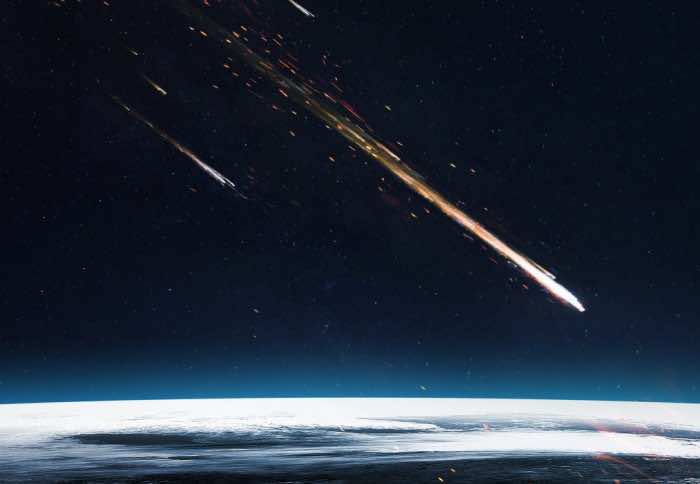 INTERNATIONAL CASABLANCA POSTS
INTERNATIONAL CASABLANCA POSTS
Two meteorite falls observed in Morocco officially recognized by the international authorities of the Meteoritical Society
“Wad Lahteyba” and “Al Farciya”
On May 9th, 2020, the Nomenclature Committee of the “Meteoritical Society” officially published the declarations of two Moroccan meteorite falls, namely “Wad Lahteyba” and “Al Farciya” whose classifications and scientific work were carried out by a team of researchers from the Hassan II University of Casablanca.
In 2019, two observed meteorite falls were reported in southern Morocco, Region: Guelmim-Oued Noun, Province: Assa-Zag. Researchers from GAIA laboratory, Hassan II University of Casablanca, Faculty of Sciences Ain Chock studied them in partnership with an American laboratory (Institute of Meteoritics, The University of New Mexico, USA) and with the help of Moroccan meteorite hunters, the Moroccan association of meteorites and ATTARIK Foundation for Meteoritics and Planetary Science.
Several eyewitnesses from the southern provinces of Morocco observed a luminous streak of yellow color going to red for a few seconds on Thursday June 27, 2019 at 5:00 p.m. (GMT + 1). It moved from the Southwest to the Northeast. No explosion has been reported. Several meteorite hunters moved to the potential site of the fall to search for pieces. Two days later, the first pieces of the meteorite were found. The fall was reported by such a large number of people that the SNRT published a short documentary on the scene of the discovery in television news on Al Oula (https://www.youtube.com/watch?v=rVIWHPRnIhc). The name given by meteorite hunters for this fall was “Lahmada”.
A few weeks later, and in the same Lahmada Lbayda region not far from Lmahbas, on Tuesday August 20, 2019 at 1:15 a.m. (GMT + 1), another meteor was seen by several residents. Eyewitnesses described a red fireball crossing the clouds, followed by two explosions. The direction of the bolide was from North to South. In the morning, searches by many meteorite hunters began despite the region’s warm August weather. In the evening, the first pieces were collected. The name given by meteorite hunters for this fall was “Khdim Chham”.
The Moroccan association of meteorites and meteorite hunter H. El Harbi provided the study samples and helped the scientists in collecting field information to have the coordinates of the meteorites collected, their masses, and the names and contact details of eyewitnesses. This data is fundamental for the submission of meteorite falls to the International Nomenclature Committee (NomCom) of the Meteoritical Society (MetSoc). This Scientific Society is the only one in the world to validate meteorite classifications.
Pr Hasnaa Chennaoui assisted by her PhD student Fatima Ezzahra Jadid from GAIA laboratory carried out the petrographic and mineralogical descriptions as well as the measurements of the magnetic susceptibility of the samples from the two falls. The geographical coordinates have been plotted on topographic maps of southern Morocco, in order to obtain the most appropriate place names and allow drawing the strewnfield. Geochemical analyzes of minerals by electron microprobe were carried out by Professor Carl Agee (Institute of Meteoritics, University of New Mexico, USA), a world reference in the study of extraterrestrial matter.
The scientific research undertaken made possible the classification of both observed falls. Concerning the fall of June 27th, 2019, it is an ordinary chondrite type H5 whose total mass has been estimated at 20 kg. The name assigned to it is “Wad Lahteyba”. The fall of August 20th, 2019, was classified as an ordinary chondrite type L6 and its total mass was estimated at 1.3 kg. The name given to it is “Al Farciya”. These names are those of the localities or places closest to the place of the falls.
These two observed falls in the southern provinces of Morocco have been officially accepted by the NomCom bringing the number of observed Moroccan falls to 20. Of this total, Professor Chennaoui of the Hassan II University of Casablanca has studied and submitted 14 of them since the Benguerir meteorite, which fell on November 22th, 2004. This research strategy, based on a close collaboration of this team of researchers with scientists from around the world and local meteorite hunters, helped to give Moroccan place names to meteorite falls collected on our country. It thus contributes to the enrichment and enhancement of the national geological heritage.
Morocco is among the best organized countries in the world for the declaration of observed meteorite falls. This dynamic, initiated at the Hassan II University in Casablanca since 2001 and supported by ATTARIK Foundation, gives it a position that honors the scientific research of our country and gives it international visibility in an extremely specific research area. As a reminder, the Hassan II University of Casablanca hosted the 77th annual meeting of the Meteoritical Society in September 2014 for the first time in Maghreb and the Middle East region. This meeting was chaired by Professor Chennaoui, it lasted a week and got the participation of 420 researchers including 40 from NASA. In addition, the 5th Martian meteorite fall “Tissint” was the subject of an article published in the journal Science (Chennaoui et al. 2012).
Contact:
Pr Hasnaa Chennaoui
GAIA laboratory director, UH2C, FSAC
Phone: 06 61 31 71 06
E-mail: hassna.chennaoui@univh2c.ma; chennaoui.hasnaa@gmail.com






